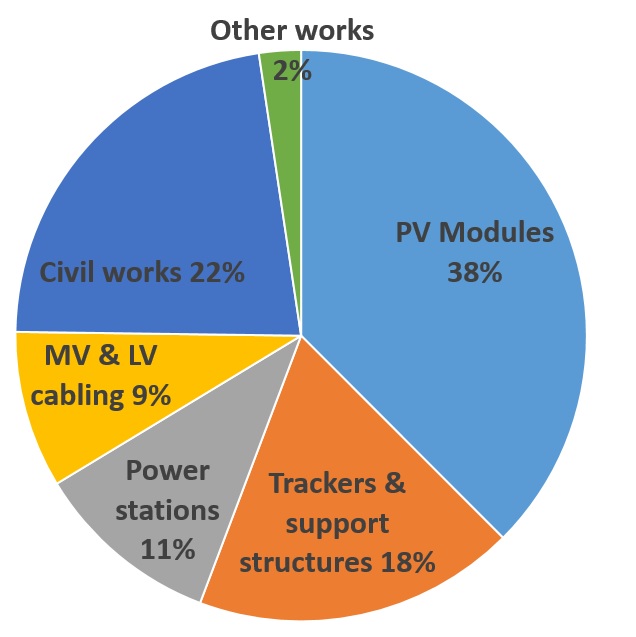As the world continues its transition towards renewable energy sources, wind farms and photovoltaic (PV) solar plants have become essential players in the quest for sustainability.
These two technologies harness the power of nature to generate clean electricity, and while they may seem quite distinct, they share common elements in their infrastructure.
Lately I have had the pleasure to spend a lot of time with my friend Alessandro.
Alessandro is an engineer specialized in the design and construction of photovoltaic plants – basically, a “solar energy” version of mine.
We spent some time discussing similarities and differences in the BoP (“Balance of Plant”) of wind farms and the BoS (“Balance of System”) of photovoltaic plants.
As you are reading this blog you will probably know that BoP and BoS basically mean “everything but the wind turbines (or the panels, in the case of BoS)”
If you are a reader of this site you certainly know what the balance of plant of a wind farm includes: BoP in wind farms refers to the infrastructure and components necessary for the proper operation of wind turbines.
BoP encompasses a wide range of systems and equipment, including foundations, electrical substation(s) to collects and transforms the electricity generated by the turbines, increasing its voltage for efficient transmission, medium voltage cabling, access roads, meteorological stations to predict wind conditions and optimize turbine performance and O&M Facilities (to house equipment and personnel for scheduled and unscheduled wind turbines maintenance).
The Balance of Service (BoS) in Photovoltaic Plants photovoltaic plants, sometimes referred to as “solar farms”, includes inverters to convert the direct current (DC) produced by solar panels into alternating current (AC) for use in the grid, mounting structures (solar panels are mounted on frames), tracking systems that rotate the panels to follow the sun and maximize exposure.
As in wind farms, you also have cabling, substation(s) and monitoring and control systems.
Both can have quite an impact on the economics of the project. For wind farm is usually in the 20% to 30% range of the CAPEX while for solar plants it is typically much more – even above 50% of the investment total.
I have made a quick number with some projects currently under development in Southern Italy and I see that for medium size projects (10 to 20 MW) the cost of the modules is only 40%.
This could sound counterintuitive but is a consequence of the unstoppable reduction of the price of the solar modules. At the current rate the price is decreasing 75% every 10 years and this trend does not seem to change.
As a consequence, the BoS becomes every year more relevant (because it is not decreasing at the same rate, so its relative weight keep increasing).
Let’s take a look at similarities and differences between BoP and BoS.
Similarities
In both cases you will need internal roads and probably a substation to connect to the grid (unless the project is very small – for projects of few MW sometimes it is possible to connect directly to the grid in medium voltage).
Additionally, sometime the panels have a shallow foundation (“ballast”) that reminds somehow the shallow foundation of wind turbines on a much smaller scale.
Furthermore the engineering works to be done (geotechnical survey, topography, electrical and civil design, etc.) are very similar.
And this is more or less where the similarities end.
Differences
The differences are much more remarkable. For instance, a substantial amount of the BoS budget comes from the support structure of the panels, inverters and trackers.
Inverters are the elements that convert the electricity produced by the solar modules for DC to AC
Trackers are used to rotate the panels in order to have them always in the best position to maximize energy production. They are optional, but they are used frequently because they are generally a cost effective technology.
It is also very unlikely that you will see a solar plant on a steep terrain (with a strong inclination), while this situation is frequent in wind farms (many of them are placed on mountain ridges).
This happen because there is a limit to the height difference that can be absorbed changing the length of the elements that sustain the panels. Additionally, excessive height differences can make the work of the trackers more burdensome with an increased risk of failures.
For these reasons the usual maximum slope in a solar plant is usually around 5% or 6% – and therefore earthworks are limited and less expensive (at least compared to some projects that I have seen on top of mountains where a lot of blasting was needed).
For the foundations I mentioned before the shallow “ballasted” solution. This is basically a block of concrete holding the modules in place.
However the use of piles is usually more cost effective. Several alternatives are available depending on the geotechnical characteristics of the soil (helical piles where cohesion is low, driven piles when the soil is more dense, etc.) and in addition to the monetary advantage they are also usually faster to install and easier to decommission at the end of the life of the project.
Other things that appear often in photovoltaic projects and are much rarer in wind power projects are video surveillance systems (basically cameras that transmit images to remote operators), fences and even motion sensors.
In many places there seems to be a significant risk of material theft (I imagine it is easier to steal panels than a turbine with a 163-metre rotor).
Finally, the choice of adding lighting, again for security reasons, is also common in solar installations and virtually non-existent in wind turbines.

Leave a Reply